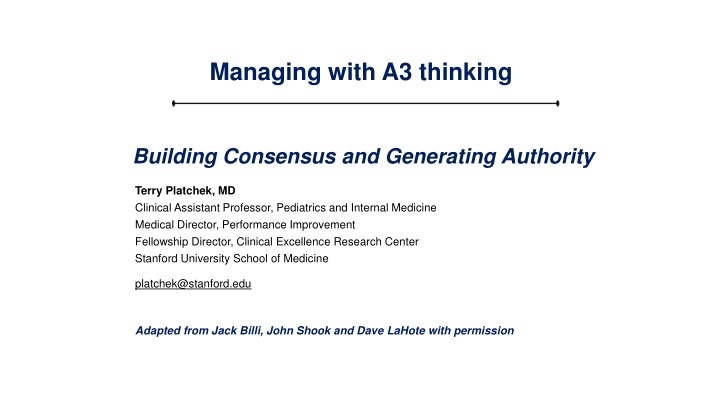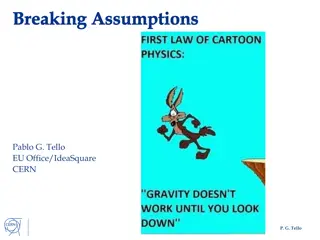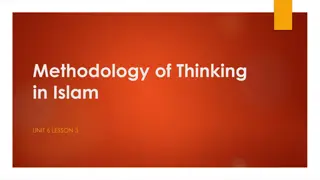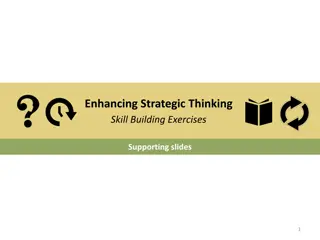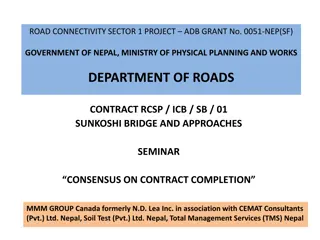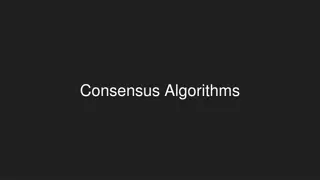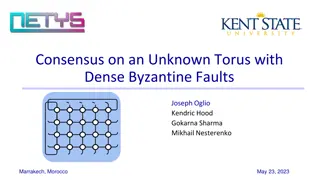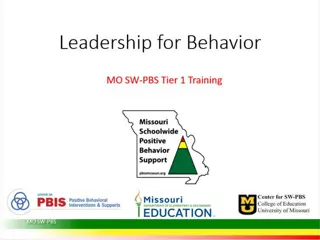A3 Thinking: Building Consensus for Project Success
Explore the key elements of A3 thinking and how it can aid in building consensus and generating authority for successful project management. Learn about the factors that contribute to project failures and the importance of agreement in aligning goals, identifying gaps, and driving towards the future state. Discover effective strategies for achieving agreement and leveraging persuasive storytelling in a concise, visual format. Embrace the A3 template as a structured approach to problem-solving and decision-making based on Toyota's standard format.
Download Presentation

Please find below an Image/Link to download the presentation.
The content on the website is provided AS IS for your information and personal use only. It may not be sold, licensed, or shared on other websites without obtaining consent from the author.If you encounter any issues during the download, it is possible that the publisher has removed the file from their server.
You are allowed to download the files provided on this website for personal or commercial use, subject to the condition that they are used lawfully. All files are the property of their respective owners.
The content on the website is provided AS IS for your information and personal use only. It may not be sold, licensed, or shared on other websites without obtaining consent from the author.
E N D
Presentation Transcript
Managing with A3 thinking Building Consensus and Generating Authority Terry Platchek, MD Clinical Assistant Professor, Pediatrics and Internal Medicine Medical Director, Performance Improvement Fellowship Director, Clinical Excellence Research Center Stanford University School of Medicine platchek@stanford.edu Adapted from Jack Billi, John Shook and Dave LaHote with permission
56th ASH Annual Meeting Disclosure Statement Terry Platchek, MD Nothing to disclose Discussion of off-label drug use: not applicable
A Question For You What makes a project fail? Think of a specific project
What Makes Projects Fail? lack of knowledge? lack of a plan? lack of leadership? lack of discipline? lack of commitment? lack of passion? lack of resources? lack of focus? lack of AGREEMENT!
Is the Issue Agreement? Do we really agree on the where we want to go? On what the gap in performance is? Future State Do we really agree on how we will get there? Do we really agree on the where we are? On the current condition? Current State
Where is Disagreement? You won t believe what they want us to do! Yea, like I m going to do that!
How Do We Get Agreement? State your case more strongly than others Force your perspective Meeting people into submission I ve got the data Do the Hard Sell
How Do You Get Agreement? Is it not most effective to tell a persuasive story? If so Would it not be best to tell it concisely, preferably visually and in a standard format?
A3 Thinking A Template for Structured Problem-Solving Background: A3 is just a paper size (~11 x 17 ). A3 began in the 1960s as the Quality Circle problem- solving format. At Toyota, it evolved to become the standard format for problem-solving, proposals, plans, and status reviews. A problem clearly stated is a problem half solved. - Dorothea Brande Adapted from John Shook
A3 Thinking A Template for Structured Problem-Solving Traits: An A3 lays out an entire plan, large or small, on one sheet of paper. tells a story, laid out from upper left to lower right, which anyone can understand. is visual and extremely concise. What is important is not the format, but the process and thinking behind it, and the conversations it facilitates. Adapted from John Shook
An A3 Problem Solving Template Date: Owner: Sponsor: Title: What we are talking about Background Of all our problems, why this one? Recommendations/Proposed Changes What are your proposed countermeasures, strategies, alternatives? How much does each cost? Tell the ugly story Current State Where do we stand? (Just the facts.) Break Down the Problem. Action items Problem Statement What specific problem? What activities are required? Aim/Goal What , Who, When? What is the specific change we want to accomplish? By when? What are the measures? Analysis of Problem Measures and Follow-up What are the root causes, requirements, constraints? What are the outcomes? Is this a new standard? How do we spread it? What issues remain? How do we honor success? Performance Improvement Last updated 7/20/11
Scientific Method (PDCA Cycle) Grasp the Situation Plan (Hypothesis) Act (Adjust) Do (Try) Check (Reflect) Countermeasures implemented as experiments
Scientific Method (PDCA Cycle) Plan (Hypothesis) Act (Adjust) Do (Try) Grasp the Situation Check (Reflect) Countermeasures implemented as experiments
A3 Benefits It fosters effective and efficient dialogue within the organization. It supports the development of problem solvers It assigns responsibility for problems or steps. It exposes lack of agreement which can undermine plans. It builds consensus and gives the authority to take action pull-based authority Adapted from John Shook
A3 Benefits It encourages PDCA (Plan, Do, Check, Act) scientific problem solving. It forces 5S for information. It clarifies the link (or lack) among problems, root causes, proposed changes. It serves as an organizational learning tool. It leads to effective countermeasures based on facts and data. Adapted from John Shook
A3 - A Template For Structured Problem Solving Date: Owner: Sponsor: Title: What we are talking about Background Of all our problems, why this one? Recommendations/Proposed Changes What are your proposed countermeasures, strategies, alternatives? How much does each cost? Tell the ugly story Current State Where do we stand? (Just the facts.) Break Down the Problem. Action items Problem Statement What specific problem? What activities are required? Aim/Goal What , Who, When? What is the specific change we want to accomplish? By when? What are the measures? Analysis of Problem Measures and Follow-up What are the root causes, requirements, constraints? What are the outcomes? Is this a new standard? How do we spread it? What issues remain? How do we honor success? Performance Improvement Last updated 7/20/11
New Patient H&P Name of Patient: History Date: Clinician: Impression - Diagnoses Chief Complaint 1. History of Present Illness 2. Past Medical & Surgical History 3. Medications and Allergies Plans Family and Social History Diagnostic: Review of Systems 1, 2, 3, Physical Exam Treatment: General Appearance, Vital Signs 1, 2, 3, HEENT Heart & Lungs Abdomen Follow - up Extremities Monitor x, y, z Neuro Return visit:
A3 Outline (Boxes) Create about five to seven boxes, combining the appropriate items to make your story as simple and clear as possible. Title (theme), owner, draft date Background Current state Goal or target Investigation of facts, analysis, root cause analysis Recommendations, countermeasures, proposed changes, strategies, alternatives Action Plan who, what, when Verification of countermeasures Review/Critique 10. Possible next steps, further action, follow up 1. 2. 3. 4. 5. 6. 7. 8. 9. Adapted from John Shook
Which Tool Could Be Used Each item (box) should contain a graph, chart, or sketch. Use words only when a graph, chart, or sketch cannot show the details of the contents, or it is impossible to explain the contents with them. BACKGROUND CURRENT STATE INVESTIGATION GOALS, OUTCOMES ANALYSIS COUNTERMEASURES ACTION ITEMS MEASURES FOLLOW-UP CHECK/REVIEW Graph Tally-sheet Pareto Diagram Scatter Diagram Control Chart Chart Cause-and-Effect Fishbone Relation Diagram Tree Diagram Pareto Diagram Scatter Diagram Graph Sketch Chart Histogram Scatter Diagram Sketch Adapted from John Shook Histogram Sketch Graph Sketch Current State Map Sketch Control Chart Histogram Graph Sketch 5 Why s Chart Future State Map Gantt Chart Pareto Diagram Chart Chart
Typical A3 Layout Date, Owner, Sponsor(s), Team Title What is this A3 is about? Recommendations What are the countermeasures being proposed and why (how do they impact the root cause)? Why these countermeasures vs. others? What does the future state look like? Background Why is this important? What is the history/context for this story? Current State What is our current performance versus the standard? What doe the current state look like? What are the biggest gaps? Action Items Action plan complete with Who, What, When Problem statement Measures and Follow Up How will we check to see if we are getting the desired results? What measures will we use? What remaining issues must we address? How will we standardize and share learnings? Grasping the Situation Goal What is our target? What are our measures? Have you clearly stated the problem (not a solution)? Is its importance to the organization clear? Aligned to the organization s purpose? Have you created understanding of the current situation? Did you go see for yourself? Analysis What is (are) the root cause(s) of the problem? How do we know this? What requirements, constraints and alternatives need to be considered? Next Steps
Typical A3 Layout Date, Owner, Sponsor(s), Team Title What is this A3 is about? Recommendations What are the countermeasures being proposed and why (how do they impact the root cause)? Why these countermeasures vs. others? What does the future state look like? measureable performance gap? What measures will you use? Goal/Aim Background Why is this important? What is the history/context for this story? Do you have a clearly defined and Current State What is our current performance versus the standard? What doe the current state look like? What are the biggest gaps? Action Items Action plan complete with Who, What, When Analysis of Root Causes Have you asked why enough times to get to root cause(s)? Problem statement Measures and Follow Up How will we check to see if we are getting the desired results? What measures will we use? What remaining issues must we address? How will we standardize and share learnings? satisfy others? Goal/Aim What is our target? What are our measures? What scientific analysis methods have you used? Will the rigor of the analysis Analysis of Problem What is (are) the root cause(s) of the problem? How do we know this? What requirements, constraints and alternatives need to be considered? Next Steps
Typical A3 Layout Date, Owner, Sponsor(s), Team Title What is this A3 is about? Recommendations/Proposed Changes What are the countermeasures being proposed and why (how do they impact the root cause)? Why these countermeasures vs. others? What does the future state look like? Background Why is this important? What is the history/context for this story? Current State What is our current performance versus the standard? What doe the current state look like? What are the biggest gaps? Action Items Action plan complete with Who, What, When Robust Countermeasures Have you generated multiple countermeasures? Problem statement Measures and Follow Up How will we check to see if we are getting the desired results? What measures will we use? What remaining issues must we address? How will we standardize and share learnings? Are the countermeasures you have chosen clearly linked to the root cause(s)? Have you used a good analytical method for deciding between them? Goal/Aim What is our target? What are our measures? Analysis of Problem What is (are) the root cause(s) of the problem? How do we know this? What requirements, constraints and alternatives need to be considered? Next Steps
Typical A3 Layout Date, Owner, Sponsor(s), Team Title What is this A3 is about? Recommendations/Proposed Changes What are the countermeasures being proposed and why (how do they impact the root cause)? Why these countermeasures vs. others? What does the future state look like? Background Why is this important? What is the history/context for this story? Current State What is our current performance versus the standard? What doe the current state look like? What are the biggest gaps? Action Items Action plan complete with Who, What, When Problem statement Measures and Follow Up How will we check to see if we are getting the desired results? What measures will we use? What remaining issues must we address? How will we standardize and share learnings? the implementation plan? Action items Goal/Aim What is our target? What are our measures? Are there clear deliverables? Does everyone understand Analysis of Problem What is (are) the root cause(s) of the problem? How do we know this? What requirements, constraints and alternatives need to be considered? Are responsibilities clearly Next Steps defined?
Typical A3 Layout Date, Owner, Sponsor(s), Team Title What is this A3 is about? Recommendations/Proposed Changes What are the countermeasures being proposed and why (how do they impact the root cause)? Why these countermeasures vs. others? What does the future state look like? Background Why is this important? What is the history/context for this story? Current State What is our current performance versus the standard? What doe the current state look like? What are the biggest gaps? Action Items Action plan complete with Who, What, When Problem statement Measures and Follow Up How will we check to see if we are getting the desired results? What measures will we use? What remaining issues must we address? How will we standardize and share learnings? Goal/Aim What is our target? What are our measures? Analysis of Problem What is (are) the root cause(s) of the problem? How do we know this? What requirements, constraints and alternatives need to be considered? Next Steps
Nemawashi Presenting a draft of the business case for the change Adjusting the business case and plan where warranted Listening, discussing, persuading, negotiating and adjusting until the key stakeholders give their agreement to proceed
Problem and PDCA Tools for different levels PDCA tool: (HK) Strategy deployment, A3 Problem: MURI, MURA Role Impact MUST PROVIDE VISION AND INCENTIVE Likes the results Problem: MURA, MURI SENIOR PDCA tool: A3 or VSM MANAGEMENT MUST LEAD THE ACTUAL OPERATIONAL CHANGE MIDDLE MANAGEMENT Requires tools and support to lead PDCA tool: Standard Work, STP Problem: MUDA Likes the involvement FRONT LINES MUST DO Key to success: The Mid-management and First Line Supervisory Level HK hoshin kanri (strategy deployment) Muri overburden Mura uneven workload Muda waste Adapted from Shook
A3 Roles 3 Roles Creating the A3 encourages systematic problem solving, using go see, ask why, respect people Presenting the A3 fosters consensus, commitment to move forward Discussing the A3 fosters critical analytic skills, communication, respect
A3 Group Learning Exercise Clearly imagine the story: Why should anybody care? Focus on the upper left hand side: What is the problem? Who owns the problem? Why is it important to the organization? How does it punch through or hurt a patient? What is the current state? What are our goals? We ll get to the lower left hand side: What are the root causes? No why before its time David Verble Filling in the right hand side is not today s goal: Recommendations, countermeasures, plans
An A3 Problem Solving Template Date: Owner: Sponsor: Title: What we are talking about Background Of all our problems, why this one? Recommendations/Proposed Changes What are your proposed countermeasures, strategies, alternatives? How much does each cost? Tell the ugly story Current State Where do we stand? (Just the facts.) Break Down the Problem. Action items Problem Statement What specific problem? What activities are required? Aim/Goal What , Who, When? What is the specific change we want to accomplish? By when? What are the measures? Analysis of Problem Measures and Follow-up What are the root causes, requirements, constraints? What are the outcomes? Is this a new standard? How do we spread it? What issues remain? How do we honor success? Performance Improvement Last updated 7/20/11
A3 Presentation Etiquette Ground-rules : Model respect: in presentation and feedback Everyone gets an 11x17 copy, for notes Present the A3 straight through Present from the A3, not slides or memory If you have a better story , use it in the A3 Listeners don t interrupt: only clarifying questions Plenty of time for feedback: time for mentoring Questions, not answers Presenter modifies A3 right now, based on the feedback
A3 References Books with Focus on A3 Use: Shook. Managing to Learn. (Best book on leadership in a lean organization and A3 use) Sobek, Smalley. Understanding A3 Thinking. (Problem solving and A3 use) Dennis. Getting the Right Things Done. (Strategy deployment or hoshin kanri) Liker, Meier. Toyota Way Fieldbook. (Practical lean tools) Baker, Taylor. Making Hospitals Work. (Workbook from Lean Enterprise Academy, UK) Graban. Lean Hospitals. (General lean healthcare reference) Lean Web Resources: Lean Enterprise Institute: www.lean.org webinars, books, meetings Lean Healthcare Value Leaders Network www.healthcarevalueleaders.org Lean Enterprise Academy (UK): www.leanuk.org Michigan Quality System at UMHS: med.umich.edu/mqs 05.17.10
